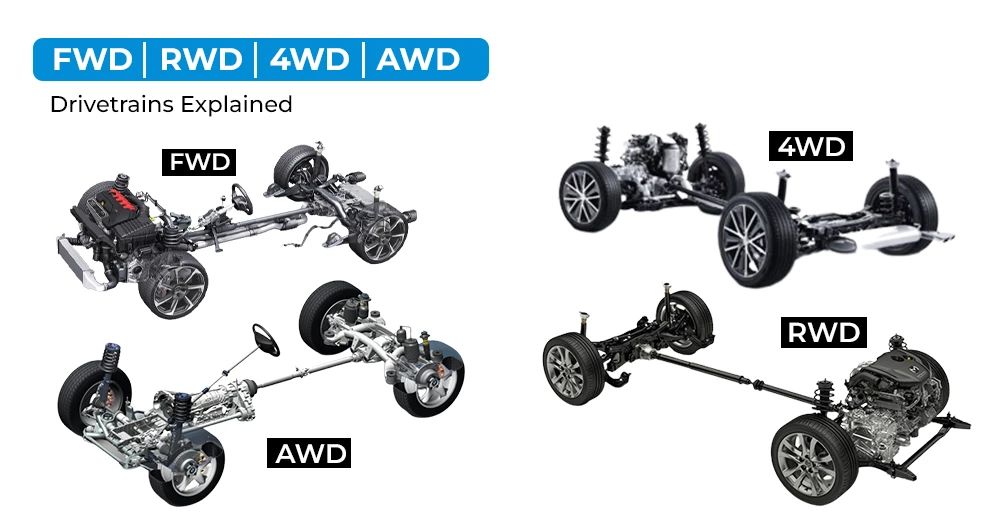Choosing between front, rear, and all-wheel drive really comes down to what you value most in a car. Front-wheel drive (FWD) sends power to the front wheels, which makes it cheaper to build, lighter, and more fuel-efficient ideal for everyday commuters who want predictable handling and decent traction when it’s wet or slick. Think of cars like the Honda Civic Si, VW Golf GTI, or Ford Focus ST: they’re fun, affordable, and slip less in the rain because the engine weight sits right over the drive wheels.
By contrast, rear-wheel drive (RWD) separates steering (up front) from propulsion (out back), giving you sharper turn-in and more balanced cornering. That’s why most track-focused cars from the Porsche 911 GT3 -RS to the BMW M3 and Chevrolet Corvette use RWD: it handles high horsepower without overwhelming grip limits, and the risk of oversteer (the back kicking out) is actually a feature for skilled drivers who prefer the chaos of throttle-steer control. On the racetrack, simplified drivetrains mean less weight, fewer parts to fail, and a pure connection between driver and tarmac, which is why formula cars and many GT racers stick with RWD.
Then there’s all-wheel drive (AWD), which funnels torque to all four corners either full-time or on demand. Because it shifts power front-to-rear (and sometimes side-to-side) in milliseconds, an AWD car can launch like a rocket and cling to corners even in snow or rain. Performance-focused examples include the Nissan GT-R, Audi RS models (like the RS 5), and Subaru WRX STI—all of which dial in a rear bias so you still get that sporty feel. Of course, those extra driveshafts, transfer cases, and clutches add complexity, weight, and cost, so AWD usually costs more on the sticker.
If you’re new to spirited driving, front-wheel drive (FWD) is the most forgiving. Push too hard, and you’ll understeer (the car drifts wide) before things get scary. All-wheel drive (AWD) comes next—grip is almost magical, so it’s hard to break traction unless you really try. Rear-wheel drive (RWD) demands practice; oversteer can catch you off guard if you’re not prepared, but nailing a controlled slide is a thrill few configurations can match.
For affordability, FWD versions of a model tend to be cheapest. RWD derivatives often sit in the mid-range (especially when paired with higher-power engines), and AWD variants almost always carry a premium for the added hardware and calibration work. Yet some manufacturers cater to all three drivetrains across their lineups: Toyota offers FWD Corollas and Camrys, RWD sports cars like the GR Supra and GR 86, as well as AWD SUVs such as the RAV4 and Land Cruiser series Honda builds FWD Civics and Accords, the RWD/ hybrid NSX, and AWD CR-Vs; Mercedes-Benz spans FWD A-Class compacts, RWD C and E-Classes, and 4MATIC versions of nearly every sedan and SUV. Even Volkswagen, Nissan, and others package models across FWD, RWD, and AWD to cover every driver’s needs.
Ultimately, the drivetrain you pick should match your budget, local weather, and how you plan to use the car. Whether you want thrifty everyday reliability, racetrack prowess, or all-condition confidence, understanding the trade-offs between FWD, RWD, and AWD steers you to exactly the right set-up.
By contrast, rear-wheel drive (RWD) separates steering (up front) from propulsion (out back), giving you sharper turn-in and more balanced cornering. That’s why most track-focused cars from the Porsche 911 GT3 -RS to the BMW M3 and Chevrolet Corvette use RWD: it handles high horsepower without overwhelming grip limits, and the risk of oversteer (the back kicking out) is actually a feature for skilled drivers who prefer the chaos of throttle-steer control. On the racetrack, simplified drivetrains mean less weight, fewer parts to fail, and a pure connection between driver and tarmac, which is why formula cars and many GT racers stick with RWD.
Then there’s all-wheel drive (AWD), which funnels torque to all four corners either full-time or on demand. Because it shifts power front-to-rear (and sometimes side-to-side) in milliseconds, an AWD car can launch like a rocket and cling to corners even in snow or rain. Performance-focused examples include the Nissan GT-R, Audi RS models (like the RS 5), and Subaru WRX STI—all of which dial in a rear bias so you still get that sporty feel. Of course, those extra driveshafts, transfer cases, and clutches add complexity, weight, and cost, so AWD usually costs more on the sticker.
If you’re new to spirited driving, front-wheel drive (FWD) is the most forgiving. Push too hard, and you’ll understeer (the car drifts wide) before things get scary. All-wheel drive (AWD) comes next—grip is almost magical, so it’s hard to break traction unless you really try. Rear-wheel drive (RWD) demands practice; oversteer can catch you off guard if you’re not prepared, but nailing a controlled slide is a thrill few configurations can match.
For affordability, FWD versions of a model tend to be cheapest. RWD derivatives often sit in the mid-range (especially when paired with higher-power engines), and AWD variants almost always carry a premium for the added hardware and calibration work. Yet some manufacturers cater to all three drivetrains across their lineups: Toyota offers FWD Corollas and Camrys, RWD sports cars like the GR Supra and GR 86, as well as AWD SUVs such as the RAV4 and Land Cruiser series Honda builds FWD Civics and Accords, the RWD/ hybrid NSX, and AWD CR-Vs; Mercedes-Benz spans FWD A-Class compacts, RWD C and E-Classes, and 4MATIC versions of nearly every sedan and SUV. Even Volkswagen, Nissan, and others package models across FWD, RWD, and AWD to cover every driver’s needs.
Ultimately, the drivetrain you pick should match your budget, local weather, and how you plan to use the car. Whether you want thrifty everyday reliability, racetrack prowess, or all-condition confidence, understanding the trade-offs between FWD, RWD, and AWD steers you to exactly the right set-up.




